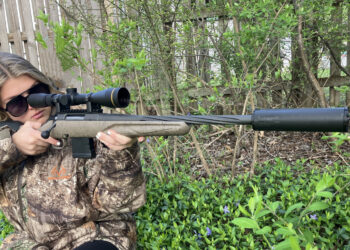By Mark Adkins
In these politically correct times, terms such as “Sporter”, “Match”, and “Target” inappropriately find their names attached to rifles which, in more innocent days, would have been given titles containing letters and numbers designating a military heritage. For a rifle to be called a “Sniper” these days, it had better be up to par! Enter the SIG SG 550-1 Sniper. Manufactured in Switzerland by Schweizerische Industrie Gesellschaft (SIG), this semi-automatic rifle chambered in .223 Remington caliber (5.56 X 45mm) more than lives up to its name. Introduced into the company’s lineup around 1989, it’s always been somewhat of a limited issue item. Its design is based on the SIG 550 series of military assault rifles known in Switzerland as the Sturmgewehr 90 (Stgw 90). But this hybrid rifle is manufactured with sniper specific features totally unique from the main issue battle rifle of the Swiss Army. This article will detail those features and evaluate the overall design.
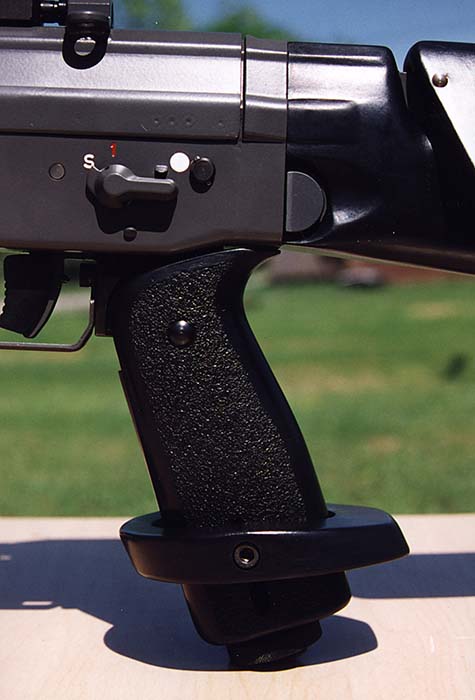
Market Share
The SIG SG-550-1 Sniper was developed in close co-operation with the special units of police forces. As such, its design concept foregoes many of the requirements a military sniper might need. Of these, both the caliber and operating system are different than most military sniper rifles, i.e., .308 Winchester chambering in a bolt-action, fixed magazine design. The 550 series rifles are .223 Remington, semi-automatic detachable magazine weapons. When looked at in terms of a police issue sniper, this combination is highly appropriate. The military sniper operates on the principles of tracking, concealment, observation, and long range engagement. Generally, one quick shot is all that is needed, with a hasty retreat to follow. On the other hand, a police sniper usually operates from a fixed location at a known distance typically under 100 meters. The accuracy requirements are the same as for the military engagement, but under different circumstances. The ability to deliver multiple follow-up shots quickly, if necessary, is at the officer’s discretion. He has this option with the semi-automatic design. The military sniper in the field usually doesn’t. Reliability is another issue. Neither can afford to have a malfunctioning weapon. Most military desire the simplicity of design that a bolt action offers. While I am sure there are many people more qualified than myself to compare the military-vs-police debate, let me just state that SIG has only made large sales of the SG 550-1 Sniper to the Swiss Policy forces and the Jordanian Palace Guard. There are no national military forces that have gone on record as purchasers. While many semi-auto/full-auto sniper rifles have entered military service worldwide, (Dragunov SVD, M14/M21, G3-SG1, etc) those choices could very well have been based on political as well as economical decisions.
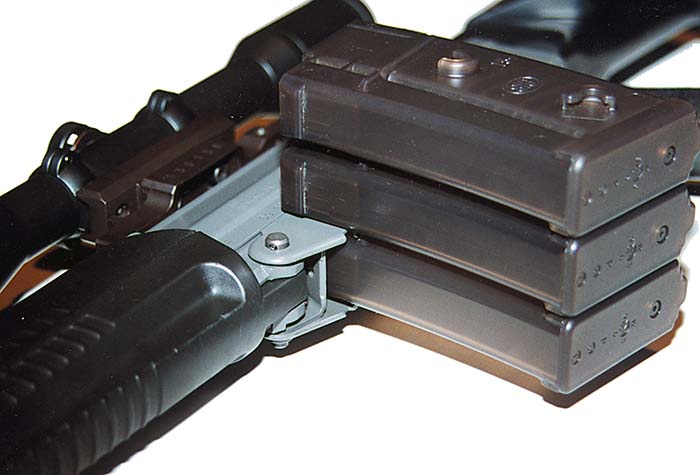
Optimum Adjusting Possibilities
The SIG SG 550-1 Sniper is by far one of the most user adjustable rifles ever made. A list of the 11 features which can be individually adjusted to suite the person firing the rifle are as follows:
Buttplate-up/down
Buttplate-rotation (cant)
Buttplate-in/out (length of pull)
Check piece-up/down
Pistol grip-front/rear (rake)
Pistol grip-hand rest up/down
Scope mount-left/right (axiel orientation)
Scope mount-front/rear (eye relief)
Bipod-leg height up/down
Bipod-left/right (cant)
Bipod-(angle of inclination)
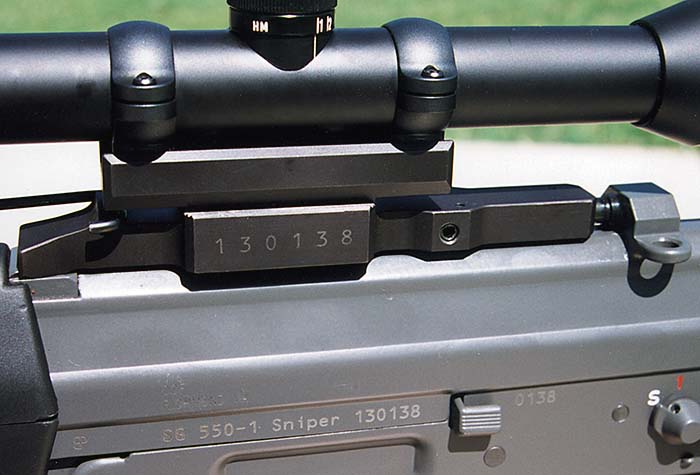
With this many adjustments available, the rifle can be adapted to the shooter’s individual anatomy and firing position. All in all, the rifle proved to be extremely comfortable to operate. The earlier manufactured buttstocks had a recess underneath which magnetically secured an Allen wrench to perform these adjustments. Later variants deleted this feature. Additionally, the entire buttstock assembly can be folded over to the right hand side, allowing the rifle to be placed into its transit case for storage.
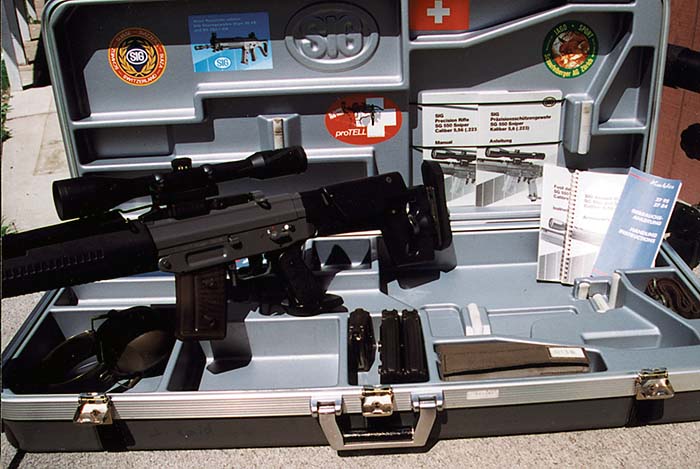
The trigger mechanism is, quite simply, an experience to behold. I have personally fired many rifles and handguns with custom trigger work, and many military designs as well. However, I have never manipulated a more precise trigger in my life! All competitive benchrest applications aside (which typically break at 2 oz.) the two-stage trigger pull and feel of the SG 550-1 Sniper is exquisite. The specifications are as follows:
Take-up weight – (800 grams) 1.75 lbs.
Pull weight – (1500 grams) 3.3 lbs.
Take-up length – 3.5mm
Trigger pull length – 4.1mm
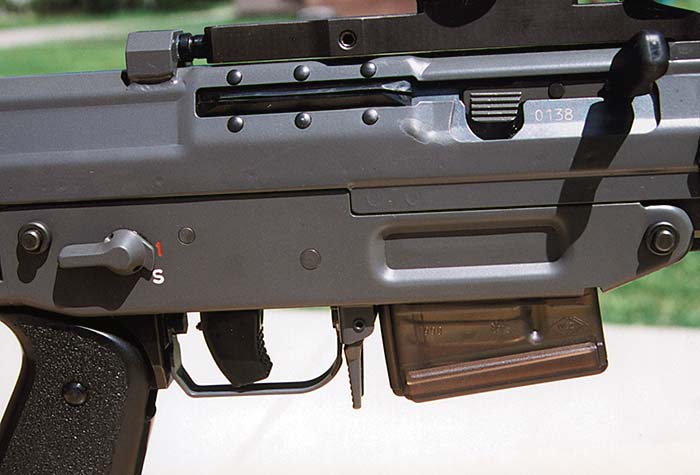
Externally, all that is visible is a large plastic trigger shoe. The trigger guard itself is designed to rotate left or right out of the way of a gloved trigger finger. Internally, a comparison between the SG 550-1 Sniper and a standard 550 trigger mechanism will show the elimination of the heavy 3-coil trigger spring, and the addition of a much lighter and relocated return spring which extends down into the pistol grip.
Likewise, a unique trigger and sear assembly contribute to the refined let-off of the sniper version. The owners manual states: “The two-stage trigger action is set optimally at our works. To ensure functional safety, the shooter should not alter any trigger settings.” No adjustments to the trigger should be necessary as it comes pre-set out of the box. Precise trigger break and pull are necessary requirements for any type of shooting accuracy. The SIG SG 550-1 Sniper definitely surpasses the standard. An ambidexterous safety lever is also included.
The gas assisted operation of the action is of the rotating bolt design. In comparison, the SIG 550 series rifles are direct copies of the AK-47 operating system. The bolt rotates and locks into battery using the same design as the Kalishnikov. The only significant difference is the location of the return spring. It is wrapped around the gas piston rod instead of being a separate spring assembly that pushes from the rear of the receiver. While this location of the return spring could subject it to the extreme operating temperatures of the gas piston and barrel, thereby ruining the temper of the spring’s steel, the Swiss Army adopted the rifle for its own use. Obviously it is suitable enough for their purposes, including fully automatic fire. On the SG 550-1 Sniper, limited only to semi-automatic, this is not at all an issue. A two-position gas valve setting is featured. One position is for regular service. The other setting is for cold or icy conditions which require more energy to cycle the action. However, recoil is increased in the latter setting thereby affecting accuracy.
Unique to the SG 550-1 Sniper, the barrel is 25.6 inches long and has a right-hand twist rate of 1-in 10 inches, with 6 grooves. It has an extra heavy barrel contour of .750” with a recessed and crowned muzzle. The metallurgical properties of the barrel are not published, but it is hammer forged and screws into the receiver. Its finish is a matte-black non-reflective coating. A black elastic anti-mirage band is fitted above the handguards to avoid heatwaves from rising off the warm barrel and distorting the view through the scope. All of the plastic furniture is colored black as opposed to the green which is usually found on the 550 Series rifles. All of the remaining metal parts and the two receiver halves are finished in a gray powder coat.
A Parker-Hale bipod is located beneath the handguards. Made of steel, this well known design has two legs which fold up underneath the handguard for storage. As mentioned earlier, it is adjustable for height and both angle of cant and inclination. Each leg has a swiveling rubber padded base.
Magazines made for the 550 rifles are produced from a transparent plastic which allows a good view of the ammunition remaining inside. A unique system of interlocking lugs and studs allow up to three magazines to be attached together side by side while inserted into the receiver. The usefulness of this feature has questionable status on a sniper rifle. If you need sixty rounds of ammunition for the situation at hand, you need another rifle! Standard magazine capacity is twenty rounds, with a five round magazine also being supplied. The low profile obtainable with the five rounder may be a worthwhile consideration. Thirty round capacity magazines are also offered by SIG. All magazines have a bolt hold-open feature which causes the bolt to lock back after the last round is ejected.
Fixed sights are not provided with the SG 550-1 Sniper. Instead, a spring loaded scope mount is attached to the top of the receiver with Allen head screws locking it rigidly into place. A detachable upper rail is interchangeable with other styles of mounting rails to accept a variety of scope platforms. NATO STANAG 2324 mounting, European rail mount, night vision devices, and various sized rings can all be adapted to fit the rifle. The scope mount pictured in this article has a set of one inch rings fitted for use with a Kahles ZFM 10X rangefinding reticle scope with a built-in bullet drop compensator. The mount has been serial numbered to match the rifle. Other scopes offered for the SIG rifles have been Zeiss, Hensoldt, and Kern optics in both fixed and variable powers. The Carl Zeiss offerings, when available, were in the 1.6 x 6, or more recently in 2.5 x 10 magnification Diavari-Z rail-mounted configuration. The Hensoldt optics would be the fixed 10X power with a tritium rangefinding reticle pattern and bullet-drop compensator , or a 1.5 x 6 x 42 variable with beta light (tritium) illumination. Some night vision may not work too well due to the lack of a flash hider on the barrel possibly causing the unit to “bloom out”. Also, as detailed previously, the mount has the ability to be moved from side to side as well as front to rear. This helps to compensate for proper eye relief as well as preventing the scope from hitting your face. These are invaluable features that I can’t recall being offered on any other scope mount.
Accessories provided include a locking storage case custom fitted specifically for the SG 550-1 Sniper. A roll-up cleaning tool kit comes with every item needed to keep the rifle in service. Sling, magazine loading tool, and Allen wrenches are also supplied. Fully illustrated owners manuals in English, German and French are provided, along with a detailed parts schematic inside, listing all items by name. Sixty-eight pages in length, other firearms manufacturers could learn a lesson from SIG in describing their weapons performance.
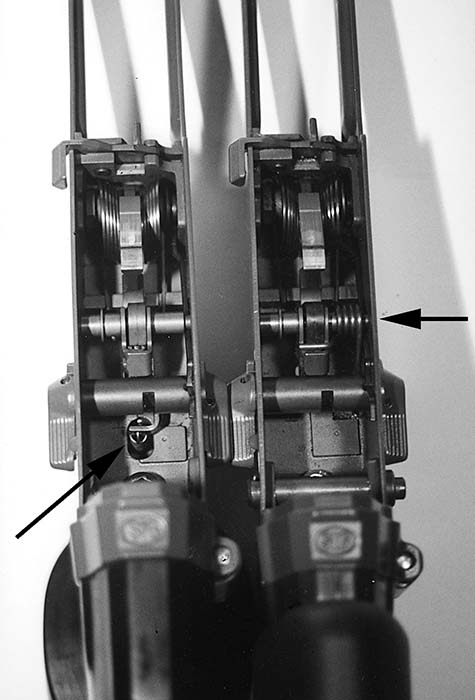
Accuracy Testing
For the sake of simplicity, all testing for this article was done at 100 yds. Unfortunately, a longer distance firing range was not available at the time of testing. In keeping with the idea of how a police sniper rifle would be used, this was acceptable. Furthermore, all groups were kept to 5 rounds each to obtain a more reliable average. The military ammunition used was Lake city SS109 (M855) green tip with a 62 grain steel core bullet. Also tested was Hirtenberger SS92 (M193) with a 55 grain bullet and Canadian IVI manufactured XM-287 using a 68 grain bullet. The hand-loaded ammunition consisted of two different loads. These were the Hornady 53 grain BTHP Match with a Federal 205 Match primer and Winchester 748 powder producing 3,150 f.p.s., and a Hornady 68 grrain BTHP Match, Federal 205 Match primer and Winchester 748 powder at 2,800 f.p.s. The purpose of this was to see if the SG550-1 Sniper barrel with its 1-in 10 inch twist rate favored the lighter or heavier weight bullets. A bullet that weighs 62 grains is stabilized with a 1-in 7 inch twist, while a 55 grain bullet is stabilized using a 1-in 12 inch twist. SIG’s own specifications call for the use of Switzerland’s GP90 ammunition, which is a 63 grain steel cored projectile. It is designed with a much more pronounced ogive than the SS109 bullet. Not having any GP90 ammo available, the two different hand-loads helped in obtaining a good combination of bullet weights.
As could be expected, the military issued ball ammunition produced flyer’s, stringing shots, and erratic performance. Both of the hand-loaded rounds used in the testing showed greatly improved performance. While the results do not show that a heavier bullet will always perform better in the SG550-1 Sniper rifle, they do show that it groups better using hand-loaded ammunition. While not always an absolute rule for all firearms, in my experiance custom loaded ammo usually groups tighter than military issued ball. It would appear that the SIG rifle does shoot best using the long, heavy Hornady 68gr. BTHP Match. The Hornady Loading Manual states that this bullet must be used with a twist rate of 1 in 10” or faster. The loading suits the SG550-1 Sniper fine, allowing it to achieve the under one minute of angle accuracy necessary for sniper work.
Final Thoughts
With the most recent Presidential Executive Order banning the further importation of the SIG SG550-1 Sniper rifle, it is now relegated to the status of a collector firearm. Only military and law enforcement agencies will be allowed to import any future quantities. The rifle evaluated for this article was one of the last brought into the United States available for civilian ownership. The importer, Capital City Firearms, can obtain no more. This is an unfortunate situation. The rifle’s high price (around $10,000 with optics) already prevented it from being a commonly encountered weapon. Target shooters and collectors of fine firearms will no longer have the opportunity to obtain one. But for a police department needing the tactical superiority that the SG550-1 Sniper provides, it would be available directly from SIG. The decision to choose this sniper rifle over others is easy to make. If the situation demands possible multiple shots, the limitless ability of adapting to the shooters anatomy, and under minute of angle accuracy, then the SIG SG550-1 Sniper is the answer. If the need arose for a .223 caliber sniper rifle, such as for issues of over-penetration and ricochet, this rifle is an obvious choice. While not a total replacement for tried and true .308 sniper systems, whether in bolt-action or semi-auto, the .223 SIG Sniper will always have its place in the law enforcement arsenal.
S.I.G., Swiss Industrial Co.
Neuhausen an Rheinfalls
CH-8212, Switzerland
02-053/21 61/11
C.C.F. Capital City Firearms
PO Box 29009
Richmond, VA 23242
1-804-740-4926
| This article first appeared in Small Arms Review V1N12 (September 1998) |





